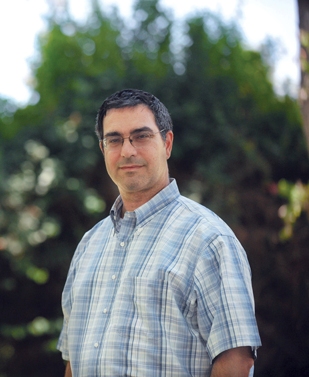Chemistry is a messy business. Complex chemical reactions typically involve numerous steps and often generate toxic waste. Transforming one chemical substance into another usually demands mixing different materials, supplying energy, adding catalysts. But chemists have a dream: One day, they hope to run chemical reactions simply by directing a laser beam at a target molecule, selectively breaking a few chemical bonds to obtain the desired product.
To the dismay of alchemists and others, this method won’t turn lead into gold (rather than breaking chemical bonds, such a change would require altering the atomic nucleus, which cannot be accomplished with lasers), but it can have a host of other advantages: Laser control can render chemical reactions effective, clean and cheap. For example, certain drugs currently produced by complex organic chemistry processes requiring several dozen transformations might in the future be obtained by considerably simpler and quicker methods.
Prof. David Tannor of the Weizmann Institute’s Chemical Physics Department, who has studied laser control of chemical reactions for more than a quarter of a century, believes the method may lead to future commercial applications. His optimism stems from the fast pace of research in leading labs around the world, including his own. Recently, Tannor and graduate student David Avisar accomplished a major feat: They developed a systematic theoretical method for reconstructing the geometrical changes occurring in a molecule after it shifts into an “excited,” high-energy state as a result of exposure to radiation. Molecules in this state emit light at characteristic times and wavelengths. As reported in
Physical Review Letters, the scientists
have analyzed this light in order to trace, in retrospect, what happened in the molecule during excitation. “What we’ve done is equivalent to reconstructing the cow by looking at the hamburger,” says Tannor.
When molecules become excited, they undergo a variety of changes: They might be stretched or twisted, and some of their chemical bonds might be broken. The Weizmann Institute reconstruction, performed by a sequence of mathematical transformations, reveals the exact sequence of events that take place in a two-atom molecule of lithium from the time it gets excited until it falls apart. The scientists are now planning to perform similar reconstructions with larger molecules made up of three or more atoms.
Such reconstruction can be a boon to laser-control chemistry because it provides crucial information about the changes induced in molecular structure by light, which in turn can make it possible to manipulate chemical bonds on demand. If the scientists know which bonds are weakened or broken following the excitation by light, they can make the process more efficient and selective with the help of specially designed laser pulses. In addition, the new understanding of excited molecules can advance the study of matter in the atmosphere and stratosphere, where a wide variety of molecules exposed to solar radiation exist in an excited state.
Beware of Traps
One major stumbling block to achieving laser control of chemical reactions is efficiency. If, say, the control is only 50 % efficient – that is, if only half of the product obtained in the reaction is the desired substance – the method will be of limited use. The goal is to reach an optimal efficiency, as close as possible to 100%.
Until recently, scientists believed that, theoretically, these high efficiencies were virtually guaranteed, provided one was persistent enough: Keep improving the precision of laser control and ultimately you will reach the optimal level. But in a
study recently published in
Physical Review Letters, Prof. David Tannor and research associate Dr. Alexander N. Pechen have shown this assumption to be false. It turns out that in certain cases, the improvement hits a dead end: What looks like a steady increase for a while, ultimately peaks at a level that falls far below 100 %. In such cases, the initial progress leads to a “trap”: Since no further improvement is possible, the scientist has no choice but to abandon the entire process and begin all over again from a different starting point.
The bad news is that these newly discovered traps make optimal efficiency more difficult to reach. The good news is that knowing about them can help scientists avoid them – for example, by applying strict criteria to the starting parameters in the improvement process.
Prof. David Tannor is the incumbent of the Hermann Mayer Professorial Chair.

